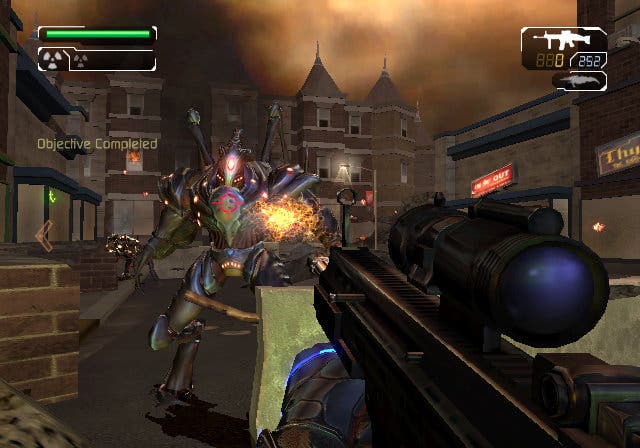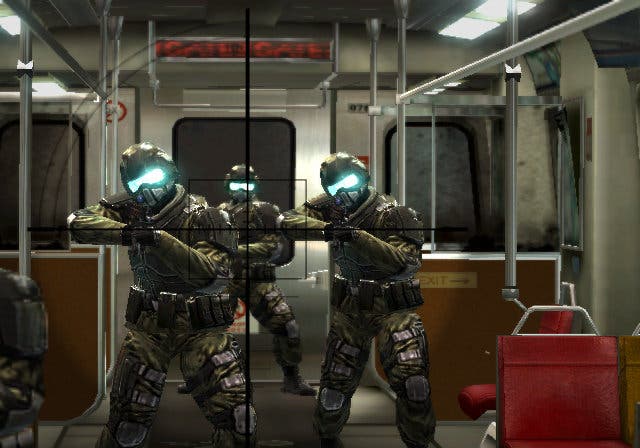The Conduit
Conduct unbecoming.
It's not the short length so much as the complete lack of depth that disappoints. There's a reasonable number of guns to use, and they do include some charge-and-release energy weapons ripped off from Halo and a novel gadget or two, like the beam gun that fires three bolts along a line determined by how you twist the remote. But there's nothing to choose between any of them for effectiveness in any given situation, and the only reason to switch between your two guns or replace one for another it all-too-frequent boredom. They've had all the life balanced out of them.
Similarly, the option to change difficulty level on the fly is welcome, but only possible because it does nothing but alter the numerical values of damage you deal and receive. It doesn't change the enemy's numbers or effectiveness, and can't do anything to conjure intelligent or surprising behaviour from their AI, or interesting dynamics from fighting them. They either run straight at you, or they don't, and you usually only have one avenue of attack.
An attempt to vary the pace a little with the inclusion of the ASE or All Seeing Eye - an orb that reveals secrets invisible to the naked eye - is as transparent as it sounds and as the clues that ham-fistedly remind you to use it. Collectables for collecting's sake, "ghost mines", puzzles without depth or purpose and the same secret bunker with the same unimpressive secret gun in it for the fourth level in a row do nothing to improve your enjoyment of the flavourless blasting. The same is true of the mechanical achievements, awarded for completing levels or shooting X number of enemies with gun Y.

It's not the visual tour-de-force we've been led to expect, either. Although smooth-running and boasting a high degree of technical polish in the effects, The Conduit suffers from weak, derivative artwork and corner-cutting in the details, and as an entrant in the Wii's beauty pageant it can't hope to hold its own against the sumptuously presented (and, for that matter, vastly more entertaining) House of the Dead: Overkill, for example.
Nonetheless, the snappy, futuristic thrill of the controls adds a great deal of the tactile satisfaction that the guns lack, and the design of The Conduit is so bland that it doesn't do much more wrong than it does right, which is very little. Shooting your way through it is unremarkable but hardly unpleasant. And it does have one notable bonus: very solid, well-engineered and enjoyable online multiplayer.
Let's not get carried away; what The Conduit achieves as a deathmatch game would be considered the bare minimum on any other platform, and it's certainly not without flaws. Matchmaking is sluggish first time, but after that you can play without pause and with little lag, even against distant players. The seven maps are well thought-out, with some devious spawn points, but the game modes are few - basic variants on deathmatch, team deathmatch, capture the flag and Oddball - and playlists get old fast, especially if you're unlucky enough to repeatedly stumble on the exhausting and ill-advised 20-minute marathon matches.

The lack of standout weapons is also a problem. A ranking system adds just enough persistence to keep things interesting for now, but it seems likely that High Voltage won't be able to give the game the nurturing and additional content it needs to survive online in the long term. Still, the lack of any competition on the platform makes this competent deathmatch the Wii's default multiplayer FPS, and it's up to the task.
On any other platform, The Conduit would sink without trace - if we'd ever heard of it in the first place. High Voltage deserves credit for its technology, for its commitment to multiplayer, and for tuning a perfect set of FPS controls on a console that was begging for them. Its efforts shame everyone but Metroid developer Retro who's gone before, and certainly do prove that you can do a great FPS on the Wii. It's just that The Conduit - slender, derivative, mechanical and uninspired - isn't it.

